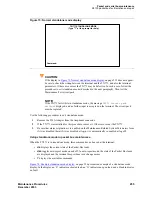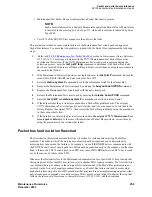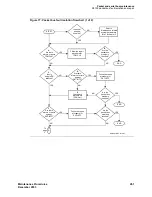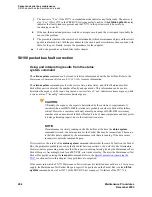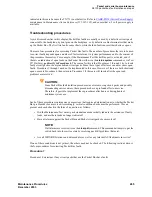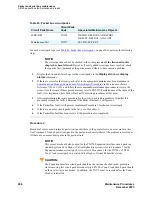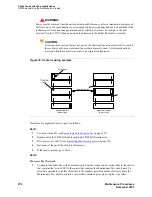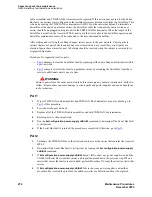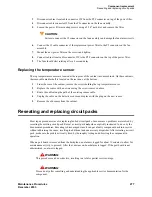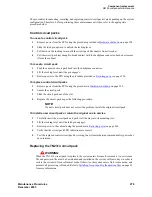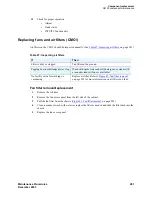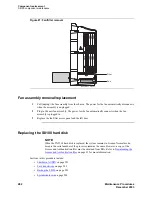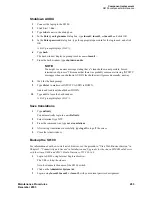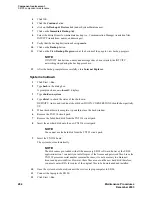
Packet and serial bus maintenance
S8100 packet bus fault isolation and repair
Maintenance Procedures
269
December 2003
9
If the Packet Bus fault does not recur, the procedure is completed.
If Procedure 3 fails to identify the cause of the problem, go to Procedure 4.
High or Critical Reliability only
In a High or Critical Reliability System, do the following:
1
If the circuit pack to be replaced is in the SPE, perform an SPE interchange by entering the
reset
system interchange
command. For an Expansion Interface circuit pack, enter the
set exp-
link
command to switch to the standby expansion link. For a Tone-Clock circuit pack, enter the
set tone-clock
command to switch to the standby Tone-Clock circuit pack.
2
Remove the newly-inactive suspect circuit pack. For a circuit pack in the processor complex, use
the procedures in the section about
3
As in Procedure 2, determine if the backplane pins in the removed circuit pack’s slot are bent.
4
If the pins are bent, do the following:
a
Power down the carrier (see
b
Straighten or replace the pins.
c
Insert the same circuit pack.
d
Restore power to the carrier (see
5
If the backplane pins are not bent, insert or replace the circuit pack.
6
Determine if the Packet Bus fault is still present.
7
If the Packet Bus fault is still present, do the following:
a
If the circuit pack was reinserted in Step 5, replace the circuit pack. Then repeat Procedure
3, starting at Step 2.
b
If the circuit pack was replaced in Step 5, continue with Step 9.
8
If the Packet Bus fault does not recur, then the procedure is completed.
9
If the suspect circuit pack has been tested in the other control carrier, go to Step 10. Otherwise,
implement Step 1, then Steps 2 through 8.
10
Repeat the procedure in the previous step for the next suspect circuit pack.
If all processor complex circuit packs have been checked and the problem is not resolved, continue with
Procedure 4.
Procedure 4
Procedure 4 tries to isolate the failure to a particular set of carriers. Only the circuit packs in those carriers
are checked. Procedure 4 is used if the preceding procedures fail, because it can help locate multiple
circuit pack failures as well as failures of the carrier hardware. The procedure is also used if there are
open leads on the Packet Bus. (The faults detected by Procedures 1 through 3 cannot cause open leads.)
In Procedure 4, the TDM/LAN Cable Assemblies and TDM/LAN termination resistor packs are replaced.
If this action does not resolve the Packet Bus fault, the carriers are reconfigured by moving the
termination resistor packs in such a manner that certain carriers are disconnected from the bus. This is
done by moving the termination resistors on the carrier backplanes. To terminate the Packet Bus at the
end of a particular carrier, first unplug the cable that connects the carrier to the next carrier and then
replace the cable with a termination resistor (see
Figure 79, Carrier rewiring example,
When the length of the Packet Bus is modified via this procedure, circuit packs that are essential to
system operation (for example, Processor Complex, Tone-Clock) must still be connected to the new
“shortened” Packet (and TDM) Bus. In addition, the Maintenance/Test circuit pack (in standalone mode)
must be connected to the “shortened” bus.
Summary of Contents for CMC1
Page 1: ...Maintenance Procedures 555 245 103 Issue 1 1 December 2003 ...
Page 14: ...Contents 14 Maintenance Procedures December 2003 ...
Page 416: ...Additional maintenance procedures IP Telephones 416 Maintenance Procedures December 2003 ...
Page 426: ...Index X 426 Maintenance Procedures December 2003 ...

